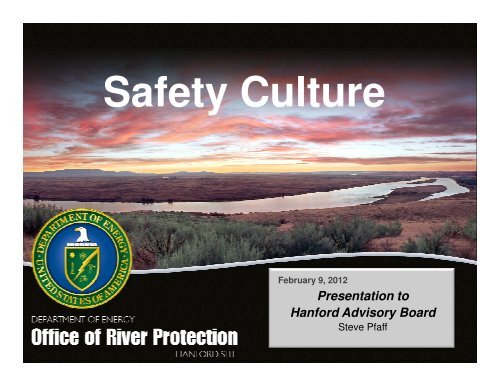Safety Culture: Presentation to HAB - Hanford Site
Safety Culture: Presentation to HAB - Hanford Site
Safety Culture: Presentation to HAB - Hanford Site
Create successful ePaper yourself
Turn your PDF publications into a flip-book with our unique Google optimized e-Paper software.
<strong>Safety</strong> <strong>Culture</strong><br />
February 9, 2012<br />
<strong>Presentation</strong> <strong>to</strong><br />
<strong>Hanford</strong> Advisory Board<br />
Steve Pfaff
<strong>Safety</strong> <strong>Culture</strong><br />
• <strong>Safety</strong> culture is an organization’s values<br />
and behaviors modeled by its leaders and<br />
internalized by its members, which serve<br />
<strong>to</strong> make safe performance of work the<br />
overriding priority <strong>to</strong> protect the workers,<br />
public, and the environment.<br />
(DOE ISMS Guide, DOE G 450.4-1C)
ORP is Not Alone!<br />
<strong>Safety</strong> is Everyone’s responsibility<br />
• Who helps us in our safety culture efforts?<br />
– Line management (at site and HQ)<br />
– Chief of Nuclear <strong>Safety</strong><br />
– DOE Office of Health, <strong>Safety</strong> and Security<br />
– Defense Nuclear Facilities <strong>Safety</strong> Board<br />
– Regula<strong>to</strong>rs<br />
– <strong>HAB</strong><br />
– Stakeholders
Initiating Events<br />
• July 16, 2010 – WTP employee raised safety<br />
culture issues in a letter <strong>to</strong> the DNFSB<br />
July 30, 2010 – EM-1 requests HSS <strong>to</strong> perform<br />
• July 30, 2010 – EM-1 requests HSS <strong>to</strong> perform<br />
independent assessment of the nuclear safety<br />
culture at the WTP Project
Learning Opportunities<br />
• HSS Report, Oc<strong>to</strong>ber 2010<br />
“…some individuals within WTP believe<br />
that there is a chilled environment that<br />
discourages reporting of safety concerns,<br />
and/or are concerned about retaliation<br />
for reporting safety concerns.”
Learning Opportunities<br />
• HSS Report, Oct. 2010 – additional excerpts<br />
– “Most ORP personnel indicated their belief that the nuclear safety culture<br />
within ORP is strong and improving.”<br />
– “Nevertheless, the nature of the concerns identified by various ORP staff<br />
members indicates a continued need for management attention on improving<br />
internal communications, particularly about ongoing and upcoming changes<br />
<strong>to</strong> the ORP procedures and organizational interfaces.”<br />
– “Although improvements are needed in some areas, BNI and its<br />
subcontrac<strong>to</strong>rs have established the framework for a strong nuclear safety<br />
culture at WTP.”<br />
– “Most WTP personnel who were interviewed expressed that their managers<br />
encouraged a questioning attitude and that they were comfortable with<br />
raising safety concerns.”
Learning Opportunities<br />
• DNFSB Recommendation 2011-1, <strong>Safety</strong><br />
<strong>Culture</strong> at the Waste Treatment and<br />
Immobilization Plant (June 2011)<br />
“The investigative record demonstrates that<br />
“The investigative record demonstrates that<br />
both DOE and contrac<strong>to</strong>r project<br />
management behaviors reinforce a<br />
subculture at WTP that deters the timely<br />
reporting, acknowledgement, and ultimate<br />
resolution of technical safety concerns.”
Learning Opportunities<br />
• Independent <strong>Safety</strong> and Quality <strong>Culture</strong><br />
Assessment Team Report (November 2011)<br />
“… no widespread evidence of a chilled atmosphere<br />
adverse <strong>to</strong> safety and no widespread evidence that<br />
DOE and Contrac<strong>to</strong>r Management suppress technical<br />
dissent.”<br />
“Although raising issues is not a problem, the timely<br />
resolution of issues stands out as a persistent and<br />
pervasive project challenge.”
Learning Opportunities<br />
• HSS Report, January 2012<br />
“While there is no fear of retaliation in the ORP work<br />
environment, there is a definite unwillingness and<br />
uncertainty among employees about the ability <strong>to</strong><br />
openly challenge management decisions.”<br />
“Fear of retaliation was identified in some groups<br />
(BNI) as inhibiting the identification of problems.”
Learning Opportunities<br />
• HSS Report, Jan. 2012 – additional excerpts<br />
“Some aspects of the ORP issues management processes<br />
are functioning effectively … such as the employee<br />
concerns program and differing professional opinion<br />
program.”<br />
“BNI enhanced new employee orientation and continuing<br />
general employee training on issue identification and<br />
resolution and <strong>to</strong>ok several actions <strong>to</strong> improve issues<br />
management processes.”
What is ORP doing?<br />
• Secretary’s memo on Nuclear <strong>Safety</strong> at the<br />
Department of Energy (December 5, 2011)<br />
• DOE Implementation Plan for DNFSB Recommendation<br />
2011-1 (December 27, 2011)<br />
• Forming a <strong>Safety</strong> <strong>Culture</strong> Team <strong>to</strong> develop and track<br />
corrective actions<br />
• All-Employee meetings and announcements<br />
• Future – Complete corrective actions and verify<br />
effectiveness<br />
• Future – DOE <strong>Safety</strong> <strong>Culture</strong> self-assessments with an<br />
emphasis on <strong>Safety</strong> Conscious Work Environment

















